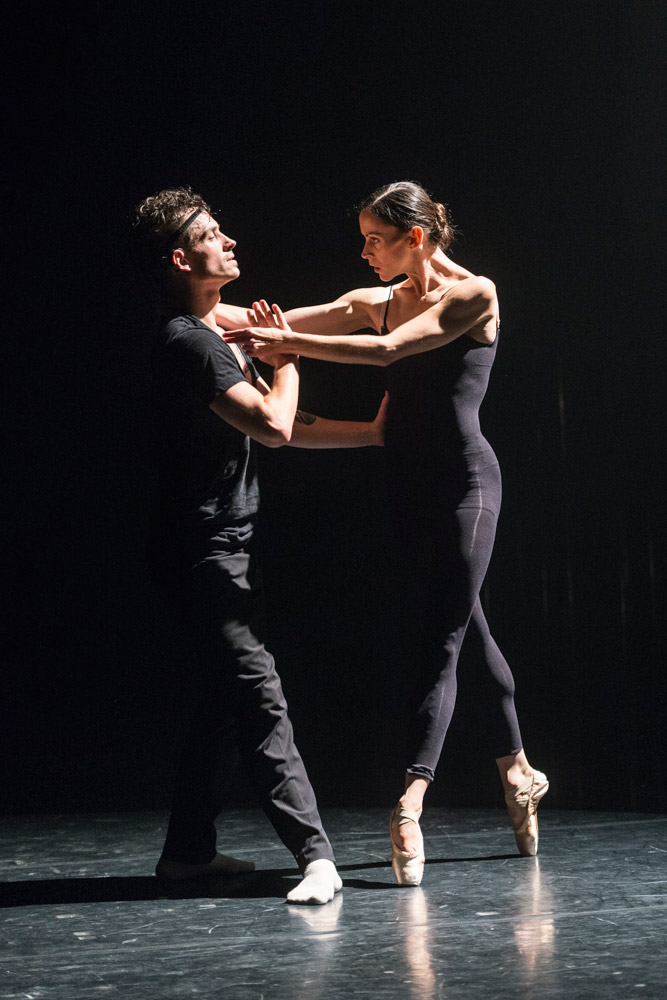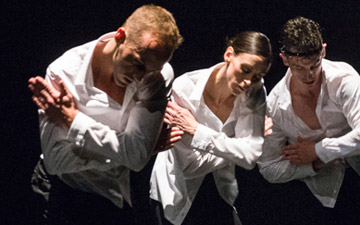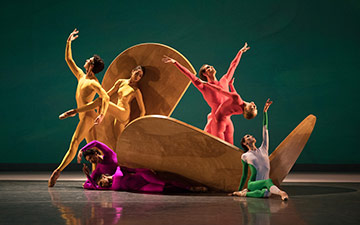
© Foteini Christofilopoulou, courtesy the Royal Opera House. (Click image for larger version)
Cas Public
Symphonie Dramatique
London, Linbury Studio Theatre
23 September 2015
Gallery of pictures by Foteini Christofilopoulou
www.caspublic.org
Almost 400 years after Shakespeare’s death in 1616, his Romeo and Juliet has been adapted in a multiplicity of forms, including those of dance – from classical ballet to hip-hop. While the Royal Ballet performs Kenneth MacMillan’s three-act version on the main stage, Hélène Blackburn’s Cas Public from Montreal gives her one-act account in the Linbury below.
Blackburn has deconstructed the story of the play and the conventions of narrative dance. The only way to follow ‘the one-hour’s traffic of the stage’ (in fact 55 minutes instead of Shakespeare’s promised two hours) is through video captions and quotations, and the speeches and shrieks of an actor-dancer, Marc-André Poliquin. Unfortunately, because this is the first time he has performed the work in English instead of the company’s native French, he is barely intelligible.
The show opens with all eight performers standing behind microphones, as if about to launch into song or Pina Bausch-type confessions. In fact, Poliquin is the only speaker, starting by reciting Shakespeare’s prologue, a summary of the plot. Spoiler alert: the star-crossed lovers are going to die.

© Foteini Christofilopoulou, courtesy the Royal Opera House. (Click image for larger version)
To a sampled sound-score by Martin Tétreault, drawing on Romeo and Juliet music by Prokofiev, Tchaikovsky, Gounod and Berlioz, the cast break into mechanical body-popping and coded sign language. They are a gang who all represent Juliet, Romeo and in one scene, Mercutio. Although Blackburn said in a pre-show event that the love-story is universal because it could take place between any couple defying a cultural, religious or ethnic divide, her French Canadian dancers, light-skinned, are dressed alike.
Mostly, they wear white shirts and dark trousers, shorts or tights. When they rearrange the stage space with benches, they wear black T-shirts with the two central characters’ names on the back, like footballers’ tops. The mobile benches serve as barriers or parkour surfaces for ferocious encounters. It’s hard to tell whether they are fights or passionate embraces. A questioning quote from Romeo: ‘Is love a tender thing? It is too rough, too rude, too boisterous’.

© Foteini Christofilopoulou, courtesy the Royal Opera House. (Click image for larger version)
Challenging duets are doubled up by other pairs, picked out in lighting effects beneath a huge many-tiered chandelier made of wine glasses. Prokofiev’s Dance of the Knights accompanies three Juliets on pointe being spun in swiftly changing directions by Romeos. When the scene changes (via a projected caption) to the Balcony pas de deux, the pointe shoes drum ominously as the women stutter in bourrées sur place. Lifts are inelegant, the women’s knees splayed sideways like frogs’ legs beneath their white tulle skirts.
Most boisterous of all is a ‘Folk Dance interlude’ that looks more like a barefoot rave or riot, unison crazy sections contrasted with sudden stillness. Captivating Cai Glover as the main Mercutio jester dies to distorted operatic voices. Tybalt, supported by men in suits, is hurled about ruthlessly in death. By now, Juliet’s pointe shoes have been replaced by vertiginous high heels. She is no longer a romantic innocent or a bereft bride, but a woman flailing against fate.

© Foteini Christofilopoulou, courtesy the Royal Opera House. (Click image for larger version)
Blackburn’s choreography is visceral, violent. The women (and sometimes men) are flung into the air, spinning like tops before being caught as they crash downwards. The principal Juliet, Isabelle Paquette, is manipulated like a disjointed puppet before being carried off, limp, in Poliquin’s arms. She’s dead, but there appears to be a rite of reconciliation towards the end. So maybe all the sacrifices haven’t been in vain. Wild, flickering dances take place beneath the lowered chandelier, which suddenly crashes to the ground, extinguishing light – and hope?
This speeded-up account of Shakespeare’s play – already hectic in language and time-span – leaves no space for reflection or regret. The lovers’ destiny is inevitable, their passions writ so large in movement that they seem almost abstract, conveyed by semaphore. If you didn’t know the play, or had never seen full-length ballets to Prokofiev’s music, the chopped-up action would be hard to grasp. What’s left to admire is the skill of the performers, committing themselves whole-heartedly to Blackburn’s vision of an inexplicably doomed love affair, as full of woe as that of Juliet and her Romeo.

















You must be logged in to post a comment.